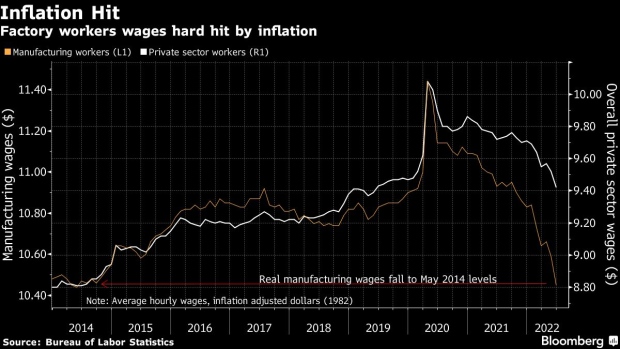Jul 13, 2022
Soaring US Inflation Hits Factory Workers, Spelling Danger for Democrats in Midterms
, Bloomberg News

(Bloomberg) -- Soaring US inflation is squeezing the living standards of manufacturing workers especially hard, adding to the danger Democrats face in key battleground states in the midterm elections.
The 9.1% increase in June consumer prices from a year earlier reported Wednesday focused fresh attention on the toll of inflation, which voters have persistently cited as their top concern heading into November’s elections. Voters historically have hardened their opinions of the economy by July in election years, giving special political weight to current financial conditions.
The buying power for manufacturing workers, a key constituency, is shrinking faster than others as costs go up, likely because they have less leverage to win wage gains from employers to make up for rising prices at the gas station, grocery store and elsewhere.
US Inflation Quickens to 9.1%, Amping Up Fed Pressure to Go Big
The disproportionate financial pain comes as the Republican Party’s populist turn under former President Donald Trump has raised the GOP’s following among blue-collar Americans. It also reprises the economic backdrop to Trump’s 2016 election, when a downturn hitting portions of the manufacturing economy fueled discontent in the industrial Great Lakes states that provided his narrow victory margin.
The deterioration in factory workers’ real wages also contrasts with good news for manufacturing that has captured headlines. Employment in the sector has rebounded at the fastest pace from any recession going back to the 1970s and there’s been a boom in construction of new facilities as US companies try to bring production home to avoid supply-chain disruptions.
Adjusted for inflation, average hourly earnings for US manufacturing workers in June had dropped to their lowest since May 2014 and were running 3.6% below the pre-pandemic annual average. By contrast, the real buying power of average hourly earnings for private-sector workers overall has fallen only to 2019 levels, merely giving up gains accrued during the pandemic stimulus and periods of labor scarcity.
The political implications are clear from the midterm electoral map. Among the seven states with the most competitive Senate races, five have above-average shares of employment in manufacturing. Wisconsin -- where Senator Ron Johnson is widely considered the most endangered Republican running for re-election this year -- is the state second-most dependent on factory jobs, with 16.2% of employment in manufacturing, nearly twice the 8.4% nationwide figure.
Other battlegrounds with above-average employment in manufacturing include Ohio, ranked 8th, where 12.4% of jobs are in manufacturing; New Hampshire, ranked 14th, 10.1% of jobs in manufacturing; and Pennsylvania, ranked 22nd, 9.5% of jobs in manufacturing. Georgia is slightly above the national average at 8.6%. The only two marquee Senate contests with below-average manufacturing are Arizona, 6.2% of jobs, and Nevada, 4.5% of jobs.
©2022 Bloomberg L.P.








